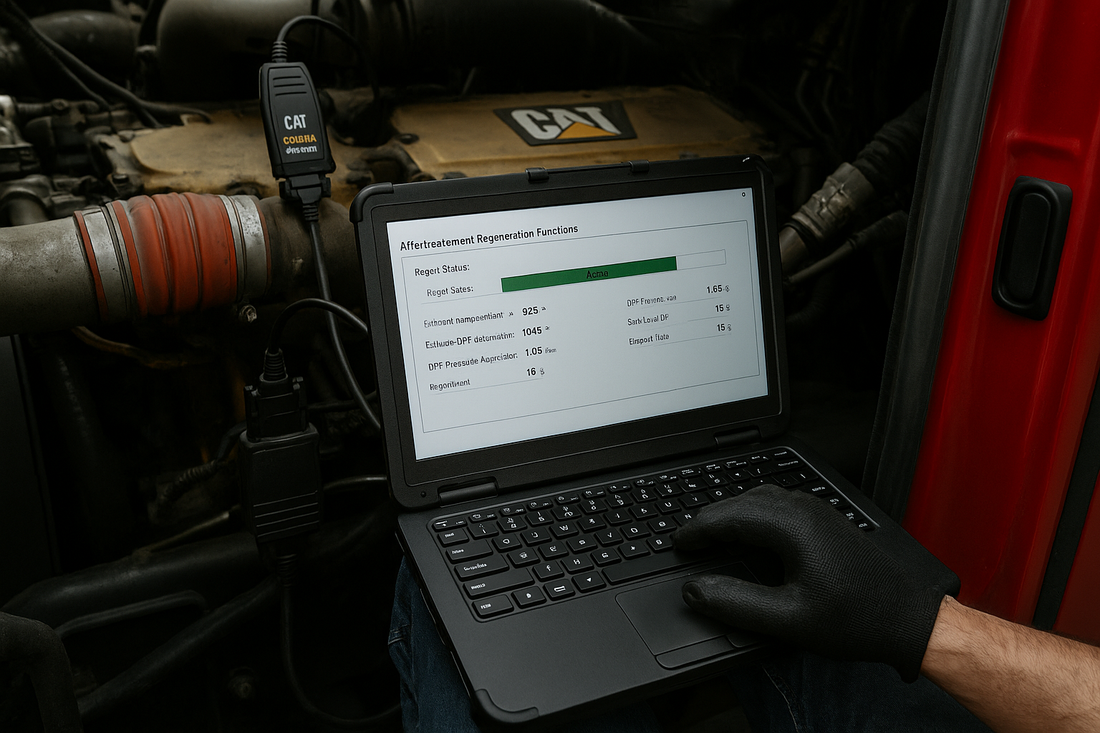
CAT Diesel Regens Explained: How to Perform a DPF Regen Safely and Effectively
Share
If you're running a Caterpillar diesel engine and see a warning light or experience power loss, you may be overdue for a DPF regeneration — also known as a forced regen. This process is essential to remove built-up soot from your diesel particulate filter (DPF) and keep your engine running at peak performance.
Here’s how to safely run a regen on your CAT diesel engine using a diesel diagnostic laptop and CAT Comm 3 adapter, without needing dealer access or subscriptions.
What Is a Regen and Why Is It Important?
The DPF (Diesel Particulate Filter) traps soot created during engine operation. Over time, this soot needs to be burned off through a process called regeneration, which:
-
Restores engine performance
-
Reduces exhaust backpressure
-
Prevents damage to the DPF and turbo
-
Keeps your engine emissions-compliant
If the DPF gets too clogged and a regen doesn’t occur, your engine may go into derate or limp mode.
How to Perform a DPF Regen on CAT Diesel Engines
1. Connect Your Equipment
-
Plug your CAT Comm 3 adapter into the vehicle’s 9-pin or 14-pin port
-
Connect the other end to your NoFeeDiesel diagnostic laptop
-
Confirm that power and communication lights are active
2. Launch Diagnostic Software
-
Open the diagnostic software pre-installed on your laptop
-
Allow the system to detect the ECM and connected modules
3. Verify Vehicle Details
-
Confirm the engine serial number, equipment ID, and model
-
Select the aftertreatment system module (this may appear as “Aftertreatment” or similar)
4. Check for Active Fault Codes
-
Before running a regen, scan for DPF, SCR, or sensor-related fault codes
-
Clear inactive codes, and resolve any active issues that may block a regen from starting
5. Start the Forced Regen
-
Navigate to the Aftertreatment or Regeneration Functions section
-
Select “Manual Regen,” “Forced Regeneration,” or equivalent
-
Follow the on-screen prompts to confirm regen start
The vehicle must be parked, in neutral, with the parking brake set.
6. Monitor the Process
During the regen, the laptop will show real-time data such as:
-
Exhaust temperatures (pre and post DPF)
-
DPF pressure differential
-
Soot load percentage
-
Regen duration and status
Expect the process to take 20 to 45 minutes depending on soot levels.
7. Post-Regeneration Check
Once the regen completes:
-
Confirm that soot and DPF pressure levels have dropped
-
Verify that regen status is “Completed Successfully”
-
Clear any temporary regen-related fault codes if necessary
-
Run a quick road test if applicable
Why You Shouldn’t Ignore a Needed Regen
Failing to perform a regen can lead to:
-
High exhaust backpressure
-
Reduced fuel economy
-
Turbo failure
-
ECM derate (loss of power)
-
Costly DPF replacement ($2,000–$5,000+)
Regularly scheduled and manually triggered regens are the key to protecting your engine and emissions system.
What You Need for CAT Diesel Regens
To perform a regen on your CAT diesel, you’ll need:
-
A rugged diagnostic laptop
-
A CAT Comm 3 adapter
-
Preloaded diagnostic software (included in NoFeeDiesel kits)
-
No subscriptions or licensing delays
